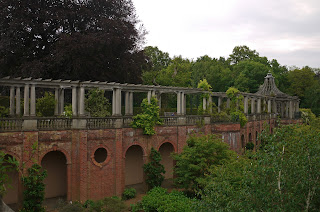Church Row
We had a free afternoon to fill in London before going to see La Bohème in the evening, so we naturally thought of doing another city walk from the excellent London's hidden walks vol 1 by Stephen Millar (Metro Publications). We decided on Hampstead, an area neither of us had veer visited.
You leave Hampstead tube station to soon reach Church Row, one of the best preserved Georgian streets in London. At the end of this terrace is the 1745 church of St John-at-Hampstead. We liked the circular window ingeniously fitted inside the clock (or maybe the other way round).
We now walked up Holly Walk to pass the rather continental-looking Catholic church of St Mary, which dates from 1816. It was built for French émigrés at a time when a new Catholic church would have been a great rarity.
At the top of nearby Holly Hill there is Fenton House, set back behind impressive gates.
This is one of the oldest houses in Hampstead. It was once the home of a successful Baltic merchant and is now run by the National Trust. It has a fine garden.
You now walk around the side of Fenton House and up Hampstead Grove. Both a large street sign and our walk book directed us to Admiral's House, built by an eccentric naval lieutenant in 1700. It seems to get its name from a character in Mary Poppins who was based on the lieutenant. Like so many buildings mentioned in the walk description, it owes its interest to who lived there (the eminent architect Sir G Gilbert Scott). I found that quite surprising, since it is an exceptionally ugly house.
We passed Hampstead Observatory, not unfortunately a miniature Greenwich, but merely some recording instruments on a small hill to reach Whitestone Pond. At 136m it is one of the highest points in London and was the location of one of the chain of beacons which gave news of the Spanish Armada. The flagpole marks the spot.
We passed the famous Jack Straw's castle pub (or rather, an ugly modern rebuilding of a famous old pub) to enter the Heath and discover a real hidden delight: the Pergola and Hill Garden, built by Lord Leverhulme behind his own massive house, The Hill. Leverhulme was also responsible for Port Sunlight, where we had a very interesting walk a few years ago.
You enter at one end of the Pergola and are immediately taken by its charm, quiet and spaciousness.
Its great scale gradually becomes apparent and it is only at the end that you can look back and fully appreciate how it was constructed.
We now walked through some woodland to emerge by another famous old pub, The Old Bull and Bush, which I had always imagined was in the East End.
Walking around the edge of the Heath brings you to Wildwood Terrace, where Nikolaus Pevsner lived for nearly 50 years. I am normally rather sniffy about houses with Blue Plaques, but Pevsner is a hero of mine and his Buildings of England series remains an essential resource.
Almost next door is the 17th century Wyldes Farm, a remarkably rural-looking building to find in a London suburb.
We emerged near Kenwood House, a grand 18th century house now owned by English Heritage, which is home to Vermeer's Guitar Player. Then along Spaniards Road and across the Heath to find ourselves in the wonderfully named Vale of Health.
We walked along this and crossed the busy East Heath Road to pass Cannon Hall (1730, once a Magistrates Court) and walk down Cannon Lane. Here there is the Old Lock Up, used for a hundred years to imprison offenders.
At the bottom there is a Victorian drinking fountain which refers to the Chalybeate (iron-enriched) water which caused Hampstead's emergence in the 18th century as a popular spa resort.
We now slightly foreshortened the walk and followed Well Walk and then Flask Walk back to the tube station, passing the Bath and Wash House of 1888 ...
... and the Flask pub, said by our guide to be one of the best in London, with fine art nouveau tiles on the outside.
Conditions: cool, cloudy, some drizzle.
Distance: about four miles.
Rating: four stars. Interesting and illuminating.















No comments:
Post a Comment